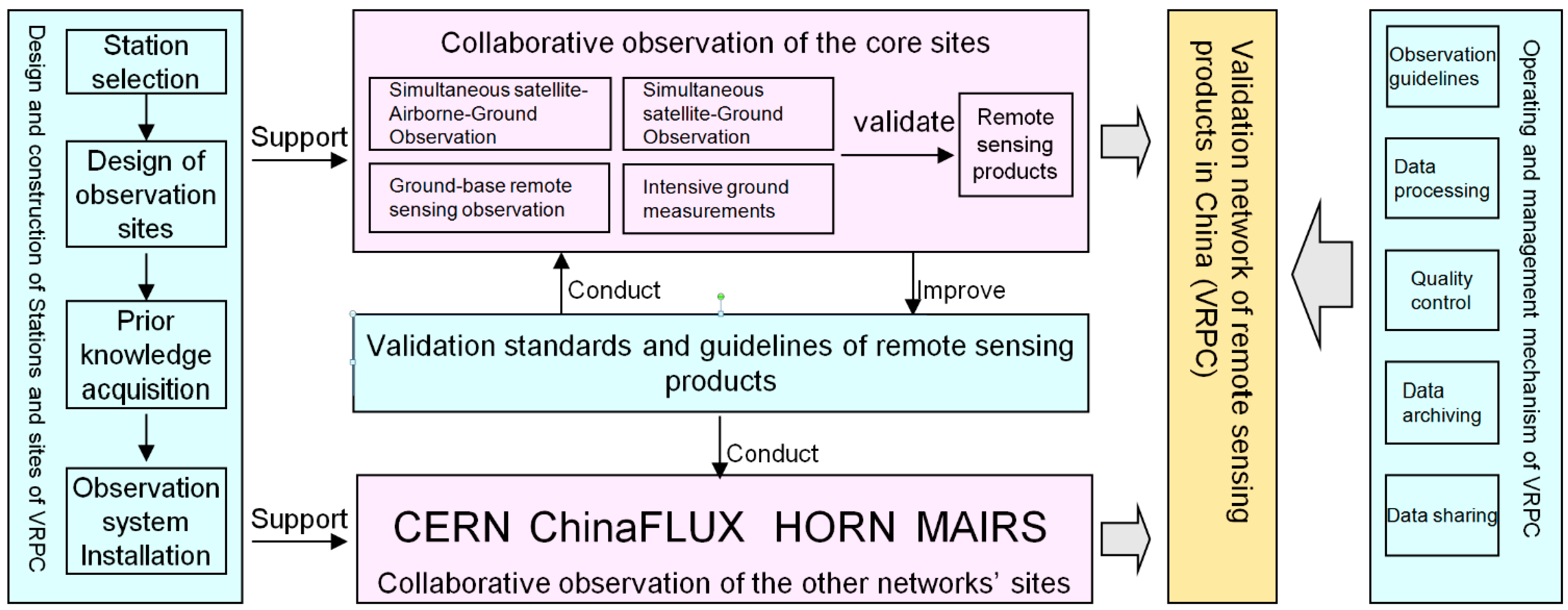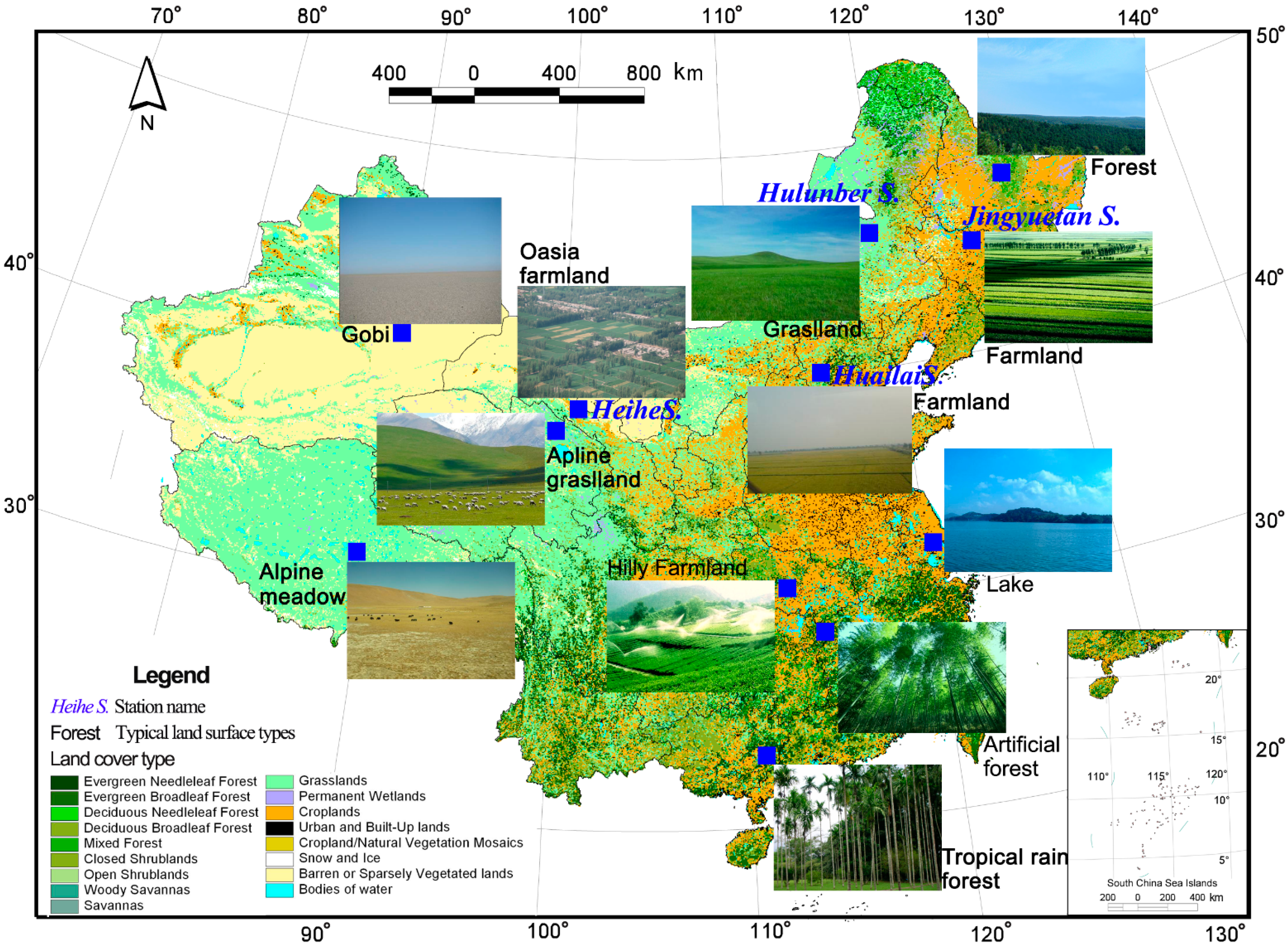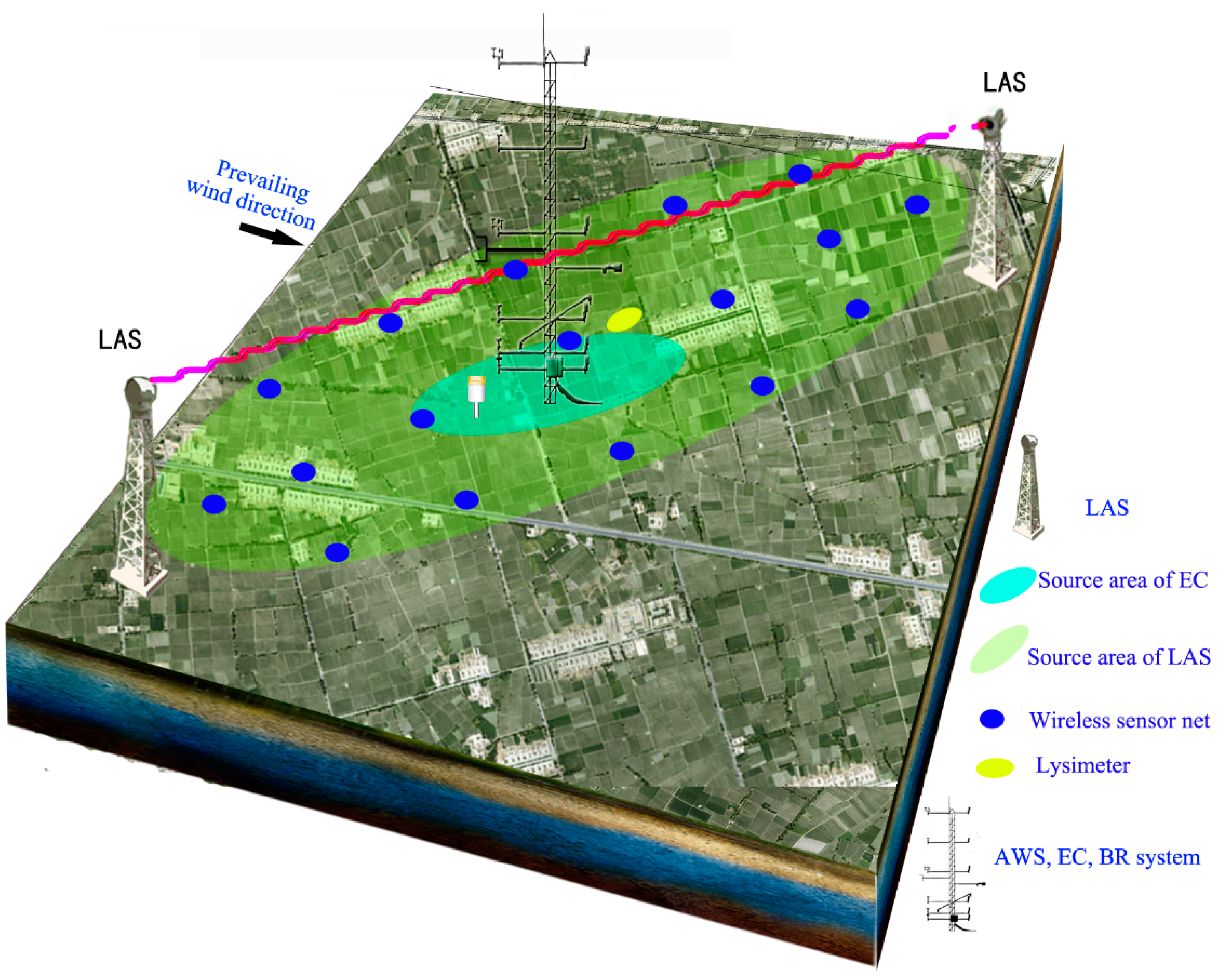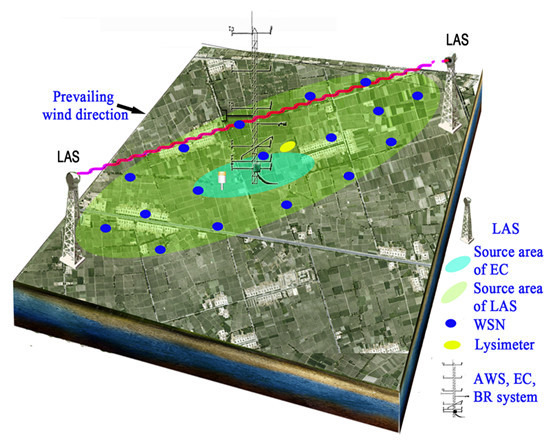A Prototype Network for Remote Sensing Validation in China
Abstract
:1. Introduction
2. Framework of the VRPC

3. Core Sites and Preliminary Stations of the VRPC

| Station Name | Core Site(Science Network) | Location | Meteorology | Land Cover | Scientific Aims |
|---|---|---|---|---|---|
| Huailai Station | East garden controlled experimental site (RSON) 100 m×100 m | Prov.: Hebei; Long.:115.783; Lat.: 40.349; Ele.: 488 | Precip.: 650; Temp.: 10 | Type: Cropland; LAI: 6.5 | Remote sensing mechanism; scale |
| Huailai Station | East garden (RSON) 1.5 km×2 km | Prov.: Hebei; Long.:115.783; Lat.: 40.349; Ele.: 488 | Precip.: 650; Temp.: 10 | Type: Cropland; LAI: 6.5 | Remote sensing mechanism; ecological protection; crop growth simulation model |
| Huailai Station | Guanting reservoir (RSON) 2 km×2 km | Prov.: Hebei; Long.: 115.740; Lat.: 40.352; Ele.: 475 | Precip.: 650; Temp.: 9 | Type: Water; LAI: 0 | Ecological protection; water resource utilization |
| Jingyuetan Station | Taipingpu controlled experimental site (RSON) 200 m×200 m | Prov.: Jilin; Long.: 125.401; Lat.: 43.998; Ele.: 211 | Precip.: 520; Temp.: 4.4 | Type: Cropland; LAI: 4 | Radiative transfer theory; soil freezing process; scale |
| Jingyuetan Station | Dehui corn(RSON) 2 km×2 km | Prov.: Jilin; Long.: 125.360; Lat.: 44.119; Ele.: 207 | Precip.: 604; Temp.: 4.8 | Type: Cropland; LAI: 5 | Validation; water balance; crop simulation growth model |
| Hulunber Station | Stipa baicalensis site (CERN) 3 km×3 km | Prov.: Inner Mongolia; Long.: 120.087; Lat.: 49.342; Ele.: 642 | Precip.: 380; Temp.: −1.0 | Type: Temperate meadow steppe; LAI: 2.5 | Validation; grassland ecosystem process model |
| Hulunber Station | Cropland site (CERN) 3 km×3 km | Prov.: Inner Mongolia; Long.: 120.034; Lat.: 49.308; Ele.: 638 | Precip.: 380; Temp.: −1.0 | Type: Cropland; LAI: 4 | Validation; crop simulation growth model |
4. Example from the Heihe Station
| Experimental Area | Validation Site | Aims, Validation Variables, and Scales | Observation Methods | Basic Information | ||
|---|---|---|---|---|---|---|
| Heihe Station Base (100.48°E,38.83°N, 20,000 m2) | Dawuhao controlled experimental site (100 m ×150 m) | Aims: Remote sensing mechanism, scale; Observation variables: Reflectance, emissivity, and brightness temperature measurements with multiple angles and polarizations; Scale: 1 m–30 m | AWS, Track crane ground-based remote sensing platform, WSN | Precip.: 110 mm; temp.: 7.8 °C; LUCC: Cropland; LAI: 5; science network: RSON; Prov.: Gansu; Long.: 100.372; Lat.: 38.856; Ele: 1524. | ||
| Babao River Basin (100.1–101.15°E, 37.72–38.32°N, 2452km2) | Babao River Basin (2452 km2) | Aims: Hydrological model driving, validation; Validation variables: Snow depth, rainfall, LST, soil moisture, soil freeze/thaw, radiation, FPAR, and albedo; Scale: 1 km–25 km | AWS (5), SMTMS (5), AR Superstation, and WATERNET1 | Precip.: 270–670 mm; temp.: 1.0 °C; LUCC: Alpine meadow, cold desert, forest, shrub; science network: IMSN, RSON. Prov.: Qinghai; Long.: 100.1–101.15; Lat.: 37.72–38.32; Ele.: 2640–5000 | ||
| A’rou freeze/thaw observation site (2 km × 2 km) | Aims: DHM and LSM development, validation, scale; Validation variables: ET, carbon flux, soil moisture, soil freeze/thaw, radiation, LST, LAI, FPAR, and albedo; Scale: 30 m–1 km | AR Superstation, EC, LAS, COMOS, and SoilNET | Precip.: 450 mm; temp.: −0.6 °C; LUCC: Alpine meadow; LAI: 3.5; science network: ChinaFLUX, IMSN, RSON. Prov.: Qinghai; Long.: 100.465; Lat.: 38.044; Ele.: 3033 | |||
| Binggou snow observation site (2 km × 2 km) | Aims: SRM and DHM development, validation, scale; Validation variables: ET, carbon flux, snow cover, snow water equivalent, and snow grain size; Scale: 30 m–1 km | AWS, SMTMS, EC, snow pillow, SWS, GMON SWE, snow stakes, and blowing snow | Precip.: 600 mm; temp.: −4.5 °C; LUCC: Cold desert; science network: RSON. Prov.: Qinghai; Long.: 100.239; Lat.: 38.014; Ele.: 4131 | |||
| Zhangye Artificial Oasis (100.22–100.55°E, 38.71–38.99°N, 900 km2) | Daman farmland observation site (3 km × 3 km) | Aims: Irrigation optimization, IHEM development, validation, scale; Validation variables: ET, carbon flux, LAI, radiation, LAI, VF, LST, soil moisture, FPAR, albedo, aerosol, and CO2; Scale: 30 m–1 km | DM Superstation, EC, LAS, COMOS, CE318, lysimeter, LAINET (15), and WATERNET2 | Precip.: 100 mm; Temp.: 8.0 °C; LUCC: Cropland; LAI: 5; science network: ChinaFLUX, IMSN, RSON; Prov.: Gansu; Long.: 100.372; Lat.: 38.856; Ele.: 1556. | ||
| Huazhaizi desert observation site (3 km × 3 km) | Aims: Ecological protection, sand prevention, water balance, validation; Validation variables: ET, carbon flux LAI, radiation, LAI, LST, soil moisture, FPAR, and albedo; Scale: 30 m–1 km | AWS, EC, and SMTMS | Precip.: 150 mm; Temp.: 9.0 °C; LUCC: Farmland; science network: RSON; Prov.: Gansu; Long.: 100.446; Lat.: 38.975; Ele.: 1460. | |||
| Zhangye northern suburb wetland observation site (2 km × 2 km) | Aims: Ecological protection, water balance, integrated model, validation; Validation variables: ET, carbon flux LAI, radiation, LAI, LST, soil moisture, FPAR, and albedo; Scale: 30 m–1 km | AWS, EC, and SMTMS | Precip.: 100 mm; Temp.: 12.1 °C; LUCC: Wetland; LAI: 4; science network: RSON; Prov.: Gansu; Long.: 100.446; Lat.: 38.975; Ele.: 1460. | |||
| Ejin Banner Natural Oasis (100.22–100.55°E, 38.71–38.99°N, 8 km2) | Sidaoqiao natural oasis site (4 km × 2 km) | Aims: Ecological protection, IHEM development, validation, scale; Validation variables: ET, carbon flux, LAI, radiation, LAI, LST, FPAR, and albedo; Scale: 30 m–1 km | SDQ Superstation, EC, LAS, and SoilNET | Precip.: 37 mm; Temp.: 8.3 °C; LUCC: Mixed forest and shrubland; LAI: 1.5; science network: RSON; Prov.: Inner Mongolia; Long.: 101.133; Lat.: 41.990; Ele.: 876. | ||


5. Discussion
5.1. Promotion of Scientific Significances by VRPC
5.2. Comparisons between the VRPC and Existing Networks
5.3. Prospects of the VRPC in Future Years
6. Conclusions
- (1)
- The framework of the VRPC has been established (Figure 1), and it has been operating with the new experimental plan.
- (2)
- Core sites were selected after full consideration of the representation of the underlying surfaces. The available remote sensing products for each site were also selected according to the observation base and land surface types. The VRPC will be constructed in several stages. Four existing stations with improved conditions have been selected for the first stage.
- (3)
- The technical criteria for field site selection and the arrangement of remote sensing product validation need to be determined before construction of the core sites. The validation standards and guidelines of the remote sensing products need to be finished early because they are important to guide collaborative observation efforts in the future.
- (4)
- The operation and management mechanisms of the VRPC need to be discussed by staff at the core sites. Data processing and data sharing after the observation experiment are important activities.
Acknowledgments
Author Contributions
Conflicts of Interest
References
- Wang, X.M.; Gao, F.; Ma, M.G. Introduction of global land imaging satellites. Remote Sens. Technol. Appl. 2006, 21, 607–611. (In Chinese) [Google Scholar]
- Ma, M.G.; Song, Y.; Wang, X.F.; Han, H.B.; Yu, W.P. Development status and application research of the time series remote sensing data products based on AVHRR, VEGETATION and MODIS. Remote Sens. Technol. Appl. 2012, 27, 663–670. (In Chinese) [Google Scholar]
- Myneni, R.B.; Hoffman, S.; Knyazikhin, Y.; Privette, J.L.; Glassy, J.; Tian, Y.; Wang, Y.; Song, X.; Zhang, Y.; Smith, G.R.; et al. Global products of vegetation leaf area and fraction absorbed PAR from year one of MODIS data. Remote Sens. Environ. 2002, 83, 214–231. [Google Scholar] [CrossRef]
- Schaaf, C.B.; Gao, F.; Strahler, A.H; Lucht, W.; Li, X.W.; Tsang, T.; Strugnell, N.C.; Zhang, X.Y.; Jin, Y.F.; Muller, J.P.; et al. First operational BRDF, albedo nadir reflectance products from MODIS. Remote Sens. Environ. 2002, 83, 135–148. [Google Scholar] [CrossRef]
- Liang, S.L. Quantitative Remote Sensing of Land Surfaces; John Wiley & Sons: Hoboken, NJ, USA, 2004; pp. 431–433. [Google Scholar]
- Justice, C.; Belward, A.; Morisette, J.T.; Lewis, P.; Privette, J.L.; Baret, F. Developments in the “validation” of satellite sensor products for the study of the land surface. Int. J. Remote Sens. 2000, 21, 3383–3390. [Google Scholar] [CrossRef]
- Morisette, J.T.; Baret, F.; Privette, J.L.; Myneni, R.B; Nickeson, J.E.; Garrigues, S.; Shabanov, N.V.; Weiss, M.; Fernandes, R.A.; Leblanc, S.G.; et al. Validation of global moderate-resolution LAI products: A framework proposed within the CEOS land product validation subgroup. IEEE Trans. Geosci. Remote Sens. 2006, 44, 1804–1817. [Google Scholar] [CrossRef]
- Cohen, W.B.; Justice, C.O. Validating MODIS terrestrial ecology products: Linking in situ and satellite measurements. Remote Sens. Environ. 1999, 70, 1–4. [Google Scholar] [CrossRef]
- Morisette, J.T.; Privette, J.L.; Justice, C.O. A framework for the validation of MODIS land products. Remote Sens. Environ. 2002, 83, 77–96. [Google Scholar] [CrossRef]
- Zhang, R.H.; Tian, J.; Li, Z.L.; Su, H.B.; Chen, S.H.; Tang, X. Principles and methods for the validation of quantitative remote sensing products. Sci. China Earth Sci. 2010, 53, 741–751. [Google Scholar] [CrossRef]
- Wu, H.; Li, Z.L. Scale issues in remote sensing: A review on analysis, processing and modeling. Sensors 2009, 9, 1768–1793. [Google Scholar] [CrossRef] [PubMed]
- Jin, R.; Li, X.; Yan, B.P.; Luo, W.M.; Li, X.H.; Guo, J.W.; Ma, M.G.; Kang, J.; Zhang, Y. Introduction of eco-hydrological wireless sensor network in the Heihe River Basin. Adv. Earth Sci. 2012, 27, 993–1005. (In Chinese) [Google Scholar]
- National Research Council (NRC). Observational networks. In Review of the WATERS Network Science Plan; National Academies Press: Washington, DC, USA, 2010; pp. 28–37. [Google Scholar]
- Liu, S.M.; Xu, Z.W.; Zhu, Z.L.; Jia, Z.Z.; Zhu, M.J. Measurements of evapotranspiration from eddy-covariance systems and large aperture scintillometers in the Hai River Basin, China. J. Hydrol. 2013, 487, 24–38. [Google Scholar] [CrossRef]
- Song, Y.; Wang, J.M.; Yang, K.; Ma, M.G.; Li, X.; Zhang, Z.H.; Wang, X.F. A revised surface resistance parameterisation for estimating latent heat flux from remotely sensed data. Int. J. Appl. Earth Obs. 2012, 17, 76–84. [Google Scholar] [CrossRef]
- Jia, Z.Z.; Liu, S.M.; Xu, Z.W.; Chen, Y.J.; Zhu, M.J. Validation of remotely sensed evapotranspiration over the Hai River Basin, China. J. Geophys. Res.: Atmos. 2012, 117, 1–21. [Google Scholar]
- Holben, B.N.; Eck, T.F.; Slutsker, I.; Tanre, D.; Buis, J.P.; Setzer, A.; Vermote, E.; Reagan, J.A.; Kaufman, Y.J.; Nakajima, T.; et al. AERONET—A federated instrument network and data archive for aerosol characterization. Remote Sens. Environ. 1998, 66, 1–16. [Google Scholar] [CrossRef]
- Baldocchi, D.; Falge, E.; Gu, L.H.; Olson, R.; Hollinger, D.; Running, S.; Anthoni, P.; Bernhofer, C.; Davis, K.; Evans, R.; et al. FLUXNET: A new tool to study the temporal and spatial variability of ecosystem-scale carbon dioxide, water vapor, and energy flux densities. Bull. Am. Meteorol. Soc. 2001, 82, 2415–2434. [Google Scholar] [CrossRef]
- Baret, F.; Morissette, J.T.; Fernandes, R.A.; Champeaux, J.L.; Myneni, R.B.; Chen, J.; Plummer, S.; Weiss, M.; Bacour, C.; Garrigues, S.; et al. Evaluation of the representativeness of networks of sites for the global validation and intercomparison of land biophysical products: Proposition of the CEOS-BELMANIP. IEEE Trans. Geosci. Remote Sens. 2006, 44, 1794–1803. [Google Scholar] [CrossRef]
- Dorigo, W.A.; Wagner, W; Hohensinn, R.; Hahn, S.; Paulik, C.; Drusch, M.; Mecklenburg, S.; Oevelen, P.V.; Robock, A.; Jackson, T. The international soil moisture network: A data hosting facility for global in situ soil moisture measurements. Hydrol. Earth Syst. Sci. 2011, 15, 1675–1698. [Google Scholar] [CrossRef]
- Ge, Y.; Wang, J.H.; Wang, J.F.; Jin, R.; Hu, M.G. Regression kriging model-based sampling optimization design for the eco-hydrological wireless sensor network. Adv. Earth Sci. 2012, 27, 1006–1013. (In Chinese) [Google Scholar]
- Kang, J.; Li, X.; Jin, R.; Ge, Y.; Wang, J.F.; Wang, J.H. Hybrid optimal design of the eco-hydrological wireless sensor network in the middle reach of the Heihe River Basin, China. Sensors 2014, 14, 19095–19114. [Google Scholar] [CrossRef] [PubMed]
- Li, X.; Li, X.W.; Li, Z.Y.; Ma, M.G.; Wang, J.; Xiao, Q.; Liu, Q.; Che, T.; Chen, E.X.; Yan, G.J.; et al. Watershed allied telemetry experimental research. J. Geophys. Res. 2009, 114, 1–19. [Google Scholar]
- Li, X.; Cheng, G.D.; Liu, S.M.; Xiao, Q.; Ma, M.G.; Jin, R.; Che, T.; Liu, Q.H.; Wang, W.Z.; Qi, Y.; et al. Heihe watershed allied telemetry experimental research (HiWATER): Scientific objectives and experimental design. Bull. Am. Meteorol. Soc. 2013, 94, 1145–1160. [Google Scholar] [CrossRef]
- Jin, R.; Li, X.; Yan, B.P.; Li, X.H.; Luo, W.M.; Ma, M.G.; Guo, J.W.; Kang, J.; Zhu, Z.L.; Zhao, S.J. A nested ecohydrological wireless sensor network for capturing the surface heterogeneity in the midstream areas of the Heihe River Basin, China. IEEE Geosci. Remote Sens. Lett. 2014, 11, 2015–2019. [Google Scholar] [CrossRef]
- Fan, W.J.; Xu, X.R.; Liu, X.C.; Yan, B.Y.; Cui, Y.K. Accurate LAI retrieval method based on PROBA/CHRIS data. Hydrol. Earth Syst. Sci. 2010, 14, 1499–1507. [Google Scholar] [CrossRef]
- Fan, W.J.; Yan, B.Y.; Xu, X.R. Crop area and leaf area index simultaneous retrival based on sptial scaling transformation. Sci. China Earth Sci. 2010, 53, 1709–1716. [Google Scholar] [CrossRef]
- Liu, Y.; Wang, J.D.; Zhou, H.M.; Xue, H.Z. LAI measuring data processing, analysis and spatial scaling in the middle reaches of Heihe experimental research region. Remote Sens. Technol. Appl. 2010, 25, 805–813. (In Chinese) [Google Scholar]
- Wang, X.F.; Ma, M.G.; Li, X. Validation of MODIS GPP product at ten flux sites in northern China. Int. J. Remote Sens. 2013, 34, 587–599. [Google Scholar] [CrossRef]
- Yu, W.P.; Ma, M.G.; Wang, X.F.; Tan, J.L. Validation of the MODIS LST products using long wave radiation ground measurements in the north arid region of China. Remote Sens. 2014, 6, 11494–11517. [Google Scholar] [CrossRef]
- Che, T.; Dai, L.Y.; Wang, J.; Zhao, K.; Liu, Q. Estimation of snow depth and snow water equivalent distribution using airborne microwave radiometry in the Binggou watershed, the upper reaches of the Heihe River Basin. Int. J. Appl. Earth Obs. 2012, 17, 23–32. [Google Scholar] [CrossRef]
- Wang, S.G.; Li, X.; Han, X.J.; Jin, R. Estimation of surface soil moisture and roughness from multi-angular ASAR imagery in the Watershed Allied Telemetry Experimental Research (WATER). Hydrol. Earth Syst. Sci. 2011, 15, 1415–1426. [Google Scholar] [CrossRef]
- Cheng, G.D.; Li, X.; Zhao, W.Z.; Xu, Z.M.; Feng, Q.; Xiao, S.C.; Xiao, H.L. Integrated study of the water-ecosystem-economy in the Heihe River Basin. Natl. Sci. Rev. 2014, 1, 413–428. [Google Scholar] [CrossRef]
- Li, X. Characterization, controlling, and reduction of uncertainties in the modeling and observation of land-surface systems. Sci. China Earth Sci. 2014, 57, 80–87. [Google Scholar] [CrossRef]
© 2015 by the authors; licensee MDPI, Basel, Switzerland. This article is an open access article distributed under the terms and conditions of the Creative Commons Attribution license (http://creativecommons.org/licenses/by/4.0/).
Share and Cite
Ma, M.; Che, T.; Li, X.; Xiao, Q.; Zhao, K.; Xin, X. A Prototype Network for Remote Sensing Validation in China. Remote Sens. 2015, 7, 5187-5202. https://doi.org/10.3390/rs70505187
Ma M, Che T, Li X, Xiao Q, Zhao K, Xin X. A Prototype Network for Remote Sensing Validation in China. Remote Sensing. 2015; 7(5):5187-5202. https://doi.org/10.3390/rs70505187
Chicago/Turabian StyleMa, Mingguo, Tao Che, Xin Li, Qing Xiao, Kai Zhao, and Xiaoping Xin. 2015. "A Prototype Network for Remote Sensing Validation in China" Remote Sensing 7, no. 5: 5187-5202. https://doi.org/10.3390/rs70505187







